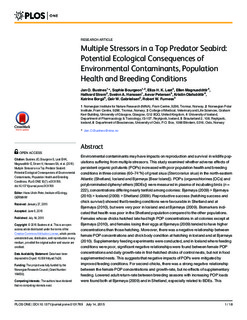Multiple Stressors in a Top Predator Seabird:Potential Ecological Consequences ofEnvironmental Contaminants, PopulationHealth and Breeding Conditions
Bustnes, Jan Ove; Bourgeon, Sophie; Leat, Eliza H. K.; Magnusdottir, Ellen; Strøm, Hallvard; Hanssen, Sveinn Are; Petersen, Aevar; Gabrielsen, Geir W.; Furness, Robert W.
Peer reviewed, Journal article

Åpne
Permanent lenke
http://hdl.handle.net/11250/2479212Utgivelsesdato
2015Metadata
Vis full innførselSamlinger
- Publikasjoner fra CRIStin - NINA [2364]
- Scientific publications [1392]
Sammendrag
Environmental contaminants may have impacts on reproduction and survival in wildlife populations
suffering from multiple stressors. This study examined whether adverse effects of
persistent organic pollutants (POPs) increased with poor population health and breeding
conditions in three colonies (60–74°N) of great skua (Stercorarius skua) in the north-eastern
Atlantic (Shetland, Iceland and Bjørnøya [Bear Island]). POPs (organochlorines [OCs] and
polybrominated diphenyl ethers [BDEs]) were measured in plasma of incubating birds (n =
222), concentrations differing nearly tenfold among colonies: Bjørnøya (2009) > Bjørnøya
(2010) > Iceland (2009) > Shetland (2009). Reproductive success (hatching success and
chick survival) showed that breeding conditions were favourable in Shetland and at
Bjørnøya (2010), but were very poor in Iceland and at Bjørnøya (2009). Biomarkers indicated
that health was poor in the Shetland population compared to the other populations.
Females whose chicks hatched late had high POP concentrations in all colonies except at
Bjørnøya (2010), and females losing their eggs at Bjørnøya (2009) tended to have higher
concentrations than those hatching. Moreover, there was a negative relationship between
female POP concentrations and chick body condition at hatching in Iceland and at Bjørnøya
(2010). Supplementary feeding experiments were conducted, and in Iceland where feeding
conditions were poor, significant negative relationships were found between female POP
concentrations and daily growth-rate in first-hatched chicks of control nests, but not in food
supplemented nests. This suggests that negative impacts of POPs were mitigated by
improved feeding conditions. For second-chicks, there was a strong negative relationship
between the female POP concentrations and growth-rate, but no effects of supplementary
feeding. Lowered adult return-rate between breeding seasons with increasing POP loads
were found both at Bjørnøya (2009) and in Shetland, especially related to BDEs. This indicates stronger fitness consequences of POPs following seasons with very poor breeding
conditions and/or high reproductive effort. This study suggests that the impacts of POPs
may differ depending on population health and breeding conditions, and that even low concentrations
of POPs could have ecological consequences during adverse circumstances.
This is important with regard to risk assessment of biomagnifying contaminants in marine
ecosystems.
